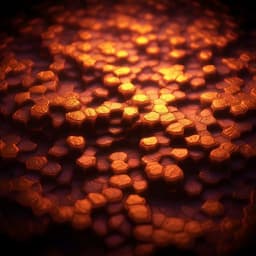
Physics
Extraordinary phase transition revealed in a van der Waals antiferromagnet
X. Guo, W. Liu, et al.
This groundbreaking research by Xiaoyu Guo and colleagues reveals a higher-temperature surface and lower-temperature bulk phase transition in CrSBr, an innovative antiferromagnet. Through advanced techniques, they discovered unexpected enhancements in surface magnetism, unveiling potential pathways to boost magnetism in 2D materials.
~3 min • Beginner • English
Introduction
The study addresses how surface and bulk ordering relate in conventional (Landau-like) phases, focusing on predicted but unverified scenarios where surface magnetic order can occur at higher temperatures than bulk order in semi-infinite systems. Theory identifies ordinary, surface, and extraordinary transitions depending on the relative strengths of surface to bulk interactions (Js/Jb). In typical 3D magnets, surface coupling is reduced and split transitions are unlikely, whereas quasi-2D van der Waals (vdW) magnets with strong intralayer and weak interlayer interactions can host distinct surface and bulk transitions. The work targets CrSBr, a vdW layered antiferromagnet with known bulk Néel temperature around 132 K and anomalous thickness dependence in which thinner samples exhibit higher magnetic onset temperatures, suggesting enhanced surface interactions. The central hypotheses are that (i) CrSBr exhibits a surface magnetic transition at a higher temperature than the bulk antiferromagnetic ordering, and (ii) the subsequent establishment of bulk order in the presence of pre-ordered surfaces constitutes an extraordinary transition.
Literature Review
Seminal theoretical works from the 1970s on semi-infinite systems (e.g., Binder & Hohenberg and successors) predicted regimes with separate surface and bulk transitions and an extraordinary transition where the bulk orders in the presence of pre-ordered surfaces. Despite extensive observations of surface-bulk correspondence in topological phases, experimental confirmation in Landau-like magnetic systems has been lacking. SHG has emerged as a powerful probe: the leading electric dipole (ED) SHG is surface-sensitive and detects inversion symmetry breaking, while next-order electric quadrupole (EQ) and magnetic dipole (MD) SHG contributions have revealed bulk phase transitions in centrosymmetric systems. CrSBr’s literature reports multiple characteristic temperatures: crossovers near ~185 K and ~155 K, bulk AFM at ~132 K, and possible low-temperature FM signatures. Notably, few-layer CrSBr shows higher onset temperatures than bulk (e.g., ~140–146 K), unlike typical vdW magnets (CrI3, Cr2Ge2Te6, Fe3GeTe2, NiPS3, FePS3, MnPSe3), hinting at enhanced surface interactions and motivating a search for split surface/extraordinary transitions in this material.
Methodology
- Sample quality characterization: High-angle annular dark-field scanning transmission electron microscopy (HAADF-STEM) in plan- and cross-section views confirmed low defect density and minimal stacking faults in bulk CrSBr crystals; atomic force microscopy showed flat, step-sparse surfaces. Heat capacity and magnetization measurements established known temperature scales.
- Nonlinear optics: Oblique-incidence second harmonic generation rotation anisotropy (SHG RA) was used to probe symmetry evolution and separate surface vs bulk contributions. Experimental setup: 800 nm ultrafast pulses (50 fs, 200 kHz), ~15 μm spot, oblique incidence θ≈11.2°, ~850 μW power. Reflected SHG at 400 nm was collected in polarization-resolved channels (Pin/Sin–Pout/Sout) while rotating azimuthal angle φ. Temperature sweeps were done with slow heating (0.5 K/min) and stabilization (additional 5 min) to ensure equilibrium; SHG RA data stability checked.
- SHG source separation and fitting: At high T, SHG RA is consistent with bulk EQ response under centrosymmetric point group mmm. Below surface and bulk ordering temperatures, the total SHG field is modeled as coherent superposition of surface ED (surface magnetic point group m′m2′) and bulk EQ (mmm or mmml′) contributions. Analytical forms for ES S,surface ED(φ) and ES S,bulk EQ(φ) were combined to construct I(φ) and fit RA patterns, extracting ED coefficients (CED = XED xyyy + 2XED xyxy, DED = XED xxxx) and EQ coefficients (DEQ x = XEQ xyxy + 2XEQ yyxx − XEQ yyyy, DEQ z = XEQ xxxx − 2XEQ xxyy − XEQ yxyx). Thickness dependence tests confirmed ED is surface-localized (thickness-independent) while EQ scales with bulk (increasing with thickness). Spatial RA mapping assessed magnetic domain sizes.
- Magnetic measurements: Temperature-dependent magnetization M(T) under 1000 Oe along the b-axis on the same crystal provided bulk TN.
- First-principles calculations: DFT-based energy mapping determined intralayer exchange couplings J1–J7 and Curie–Weiss temperature Tcw for four structural scenarios: S1 (bulk), S2 (rigid monolayer with bulk intralayer geometry), S3 (fixed-ab monolayer with intra-unit-cell relaxation at bulk lattice constants), S4 (fully relaxed free monolayer). Structure relaxations used VASP (PAW, PBE-GGA; bulk k-mesh 6×6×4, monolayer 7×7×1; 900 eV cutoff; force convergence <3 meV/Å; optB88-vdW for dispersion). All-electron FPLO used for energies; GGA+U with FLL double counting, J=0.72 eV, U varied across a wide range. An 8-fold supercell (16 inequivalent Cr) enabled determination of J1–J7 via fitting to Heisenberg Hamiltonian H=∑Jij Si·Sj (S=3/2). Tcw computed from exchange constants; analysis connected changes in intralayer exchange and small anisotropy/interlayer terms (J′) to TN via known quasi-2D formulas.
Key Findings
- Direct observation of split transitions in bulk CrSBr: a higher-temperature surface antiferromagnetic ordering at Ts = 140 ± 0.2 K and a lower-temperature bulk Néel transition at TN = 132 K, i.e., an extraordinary transition of the bulk in the presence of pre-ordered surfaces.
- SHG RA signatures: High-T RA patterns (e.g., 185 K) are well-described by bulk EQ SHG with mmm symmetry. Below TN, two distinct SHG RA patterns appear corresponding to two degenerate magnetic domain states (A and B), related by broken C2c/ma/TR symmetries; domain sizes up to ~500 μm and random selection across thermal cycles. Interference of surface ED and bulk EQ SHG leads to constructive vs destructive lobes that are opposite between domains A and B.
- Temperature evolution extracted from RA fitting:
• CED(T) (surface ED, ∝ Néel vector N) exhibits an order-parameter-like onset at Ts ≈ 140 K and a kink at TN ≈ 132 K, confirming surface order precedes bulk order and is affected by the extraordinary bulk transition.
• DEQ(T) (bulk EQ, ∝ constant + N·N) shows gradual increase below ~185 K, a slope change at T* ≈ 155 K, a weak divergence-like peak at Ts ≈ 140 K, and a kink at TN ≈ 132 K, consistent with sensitivity to spin correlations within the optical penetration depth.
- Reinterpretation of intermediate temperature scale: The ~155 K feature is assigned to a crossover into fluctuating short-ranged spin patches (within and between ab planes), not a true phase transition to a c-axis-incoherent FM state, resolving thermodynamic inconsistencies.
- Thickness dependence: Below TN, EQ SHG increases with sample thickness (bulk origin) while ED SHG remains constant (surface origin), supporting the source assignment.
- DFT mechanism for enhanced surface magnetism: Tcw increases from bulk (S1) to rigid monolayer (S2), further increases in fixed-ab monolayer (S3), and slightly decreases in fully relaxed monolayer (S4); trend robust across U. Two key contributors to higher surface TN: (i) absence of neighboring layers and (ii) intra-unit-cell lattice relaxation. Microscopic exchange changes: removal of neighboring layers boosts intralayer FM exchanges J1 and J2 by ~1 K each (suppression of AFM hopping paths via adjacent layers); intra-unit-cell relaxation increases J2 (~1 K) and J3 (~2 K) via Cr–S–Cr angle modifications. Overall, enhanced intralayer exchange dominates TN enhancement (linear effect), while anisotropy/interlayer terms contribute logarithmically.
- Additional observations: Heat capacity reproduces known temperature scales (~185 K, ~155 K, 132 K). Magnetization M(T) shows expected divergence at TN ≈ 132 K. RA at high T excludes significant surface ED, bulk MD, or EFISH as primary sources.
Discussion
The results experimentally validate the long-standing prediction that surface magnetic order can emerge at higher temperature than bulk order in a semi-infinite system, and that the ensuing bulk ordering in the presence of surface order is an extraordinary transition. By leveraging the complementary sensitivities of ED (surface) and EQ (bulk) SHG and their coherent interference, the study disentangles surface and bulk contributions, identifies domain states, and tracks their temperature evolution. The observation of Ts > TN in bulk CrSBr directly links to the quasi-2D nature of vdW magnets with strong intralayer and weak interlayer couplings (Js ≫ Jb), fulfilling conditions for split transitions. The DFT analysis elucidates that enhanced intralayer exchanges at the surface—due to both absent neighboring layers and intra-unit-cell relaxation—overcome increased surface fluctuations and elevate the surface ordering temperature. The reinterpretation of the ~155 K scale as a crossover to short-ranged correlated patches aligns with the smooth EQ SHG evolution and resolves prior thermodynamic inconsistencies. Collectively, these findings establish vdW magnets as fertile ground for exploring surface/extraordinary transitions and suggest routes to engineer and enhance magnetism in 2D limits.
Conclusion
This work demonstrates a clear separation between surface and bulk magnetic transitions in bulk CrSBr: a surface antiferromagnetic transition at Ts ≈ 140 K and an extraordinary bulk Néel transition at TN ≈ 132 K, validated through SHG RA with ED/EQ source separation and corroborated by magnetometry. First-principles calculations attribute the enhanced surface ordering to increased intralayer exchange arising from the absence of neighboring layers and intra-unit-cell relaxation. The study advances fundamental understanding of semi-infinite critical phenomena in quasi-2D magnets and offers practical strategies to enhance 2D magnetism. Future directions include: exploring related vdW magnets (e.g., chromium chalcogenide/oxyhalides, VI3) for similar split transitions; tuning exchange via static strain or dynamic nonlinear phononics to raise critical temperatures; and exploiting twist-induced moiré superlattices in CrSBr, where intralayer exchange may be periodically modulated and electronic anisotropy could yield novel moiré magnetic/electronic states.
Limitations
- The SHG-based separation of surface ED and bulk EQ contributions relies on symmetry-based modeling and interference fitting; while thickness dependence supports assignments, the approach is indirect and depends on assumed point groups.
- EQ SHG probes within the optical penetration depth, which includes surface layers; thus, bulk correlation signals may include near-surface contributions.
- First-principles calculations used isotropic Heisenberg models (biaxial anisotropy is much smaller) and were designed to explain trends rather than predict exact critical temperatures; the authors state the calculations cannot yield precise TN values for surface and bulk matching experiment.
- The crossover at ~155 K is inferred from SHG and compared to literature; direct microscopic confirmation of short-ranged spin patches is not presented.
Related Publications
Explore these studies to deepen your understanding of the subject.







